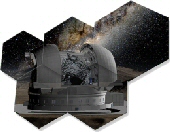Italiano:
Ecco una famosa “Triade” di crateri lunari: i crateri Teophilus, Cyrillus e Catharina, situati nella zona centro sud-orientale della faccia a noi visibile della Luna, visibili anche con piccoli telescopi 5 giorni dopo la Luna nuova (quindi in fase crescente) oppure, come in questa mia ripresa, 4 giorni dopo la Luna piena.
Si tratta di tre crateri tutti estesi all’incirca 100 chilometri e di formazione molto antica, sebbene Teophilus (il primo dei tre dall’alto) sia più recente (da 3,2 a 1,1 miliardi di anni fa) degli altri due.
L’orlo di “Teophilus” ha un’ampia superficie interna terrazzata che mostra segni di frane. Il cratere ha una profondità di 4200 metri (!) con pareti massicce che si sono fratturate, scontrandosi nell’impatto originario, con una seconda formazione, il cratere Cyrillus. Ha un’imponente montagna centrale, alta 1.400 metri, con tre picchi di grandezze scalari, qui molto evidenti, di cui il picco occidentale è designato Psi (ψ), quello orientale Phi (φ) e il picco settentrionale è Alpha (α) Theophilus.
Il cratere “Cyrillus” è un cratere da impatto lunare situato sul bordo nord-ovest del Mare Nectaris, ed è il centrale dei tre in questa mia immagine. Il cratere Teofilo, di impatto successivo come già detto, si intromette nel bordo nord-est. Le pareti del cratere Cyrillus rimangono intatte fino al punto di congiunzione con Teophilus.
Il fondo di Cyrillus contiene tre ridotte montagne centrali leggermente a nord-est del suo centro, che si innalzano ad altezze di 1.000 metri sopra il pavimento di Cyrillus: Cyrillus Alpha, Delta ed Eta.
Il terzo e ultimo dei tre, il cratere “Catharina” (in basso nell’immagine), si trova in un aspro tratto di terreno lunare tra la scarpata chiamata Rupes Altai (ad ovest di esso) e il Mare Nectaris (ad est) e tutto il trio di crateri è incorniciato dalla curva delle “Rupes Altai”.
Il bordo di Catharina è fortemente usurato e irregolare e nulla rimane dell’originario picco centrale. La maggior parte della parete nord è incisa dal bordo consumato del cratere Catharina-P, mentre la parete nord-est è profondamente bombardata da numerosi crateri più piccoli.
Sono presenti, nell’immagine ripresa, anche il cratere “Beaumont”, il cratere “Ibn-Rushd” (o Averroes), il cratere “Kant” (visibile parzialmente sul bordo sinistro) ed il Mons Penck.
Quest’ultimo, è un promontorio che si trova appena a nord-est del cratere Kant, a nord di Ibn-Rushd e della scarpata Rupes Altai, ha un diametro alla base di circa 30 km e risale fino ad un’altitudine di oltre 4 km !!
Grazie per la Vostra attenzione e… ad maiora semper! 😉
Dettagli tecnici:
Telescopio Astrofaktoria DK20 @ ~ F/19 – Baader FFC Multiplier – Baader IR 685nm filter – GS3-U323S6M-C camera – Seeing 6,5-7/10 in IR band – sito: Palermo @ my personal Observatory.
English:
Here is a famous “Triad” of lunar craters: Teophilus, Cyrillus and Catharina craters, located in the central south-eastern area of the Moon face visible, also appears with small telescopes 5 days after the new Moon or, as in this my captured image, 4 days after the full moon.
These are three craters, all about 100 kilometers large and of very ancient formation, although Teophilus (the first of the three from above) is more recent (from 3.2 to 1.1 billion years ago) than the other two.
The rim of “Teophilus” has a large terraced internal surface showing signs of landslides. The crater has a depth of 4200 meters (!) with massive walls and was fractured by colliding, in the original impact, with a second formation, the Cyrillus crater. It has a central mountain, 1.400 meters high, with three peaks of scalar quantities, very evident here, of which the western peak is designated Psi (ψ), the eastern one Phi (φ) and the northern peak is Alpha (α) Theophilus .
The “Cyrillus” crater is a lunar impact crater located on the northwest edge of the Mare Nectaris, and is the center of the three in this image of mine. The Theophilus crater, of subsequent impact as already mentioned, intrudes into the north-eastern edge.
The walls of the Cyrillus crater, remain intact up to the point of conjunction with Teophilus.
The bottom of Cyrillus contains three small central mountains slightly north-east of its center, which rise to heights of 1,000 meters above the Cyrillus floor: Cyrillus Alpha, Delta and Eta.
The third and last of the three, the “Catharina” crater (bottom of the image), is located in a rugged stretch of lunar terrain between the escarpment called Rupes Altai (west of it) and Mare Nectaris (east) and the whole trio of craters is framed by the curve of the “Rupes Altai”.
The edge of Catharina is heavily worn and irregular and nothing remains of the original central peak. Most of the north face is engraved by the worn edge of the Catharina-P crater, while the north-east face is deeply bombarded by numerous smaller craters.
There are also visibles the “Beaumont” crater, the “Ibn-Rushd” (or Averroes) crater, the “Kant” crater (partially visible on the left edge) and Mons Penck.
The latter is a promontory located just north-east of the Kant crater, north of Ibn-Rushd and the Rupes Altai escarpment and has a base diameter of about 30 km and goes up to an altitude of over 4 km (13.000 ft) !!
Thanks for your attention and … ad maiora semper! 😉
Technical details:
Astrofaktoria DK20 @ ~ F/19 – Baader FFC Multiplier – Baader IR 685nm filter – GS3-U323S6M-C camera – Seeing 6.5-7/10 in IR band – site: Palermo @ my personal Observatory


